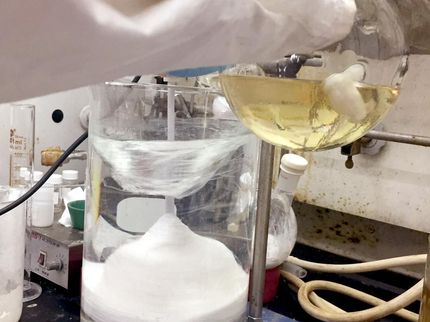Researchers discover an alternative to PEG
rPEG as a new type of Poly(ethylene glycol): random chains offer multiple advantages for medical application
Researchers have discovered a highly promising replacement for polyethylene glycols (or PEGs), which are considered almost indispensable in the pharmaceutical and medical fields. The new substance class called rPEG offers all the advantages of PEGs, while avoiding their drawbacks and has the potential to evade adverse reactions of the immune system and its antibodies. PEGs have gradually lost this ability over recent years. "We intend to create a platform technology based on these rPEGs that will open up an extensive range of possible applications," stated Professor Holger Frey of Johannes Gutenberg University Mainz (JGU). He and his team managed to develop the new substance class about three years ago. "We already have a wealth of ideas for using the new rPEG class in the future, starting with medicine through pharmaceutical applications to the materials sciences," added Dr. Rebecca Matthes of the rPEG team at Mainz University.
Polyethylene glycols – highly effective for decades
Polyethylene glycols are allrounders in the chemical and pharmaceutical industries, considering the many ways they are used. PEGs are present in shower gels and toothpastes, washing powders and rechargeable lithium-ion batteries, baking mixes and functional clothing. The recovered wreck of the legendary Vasa, a royal Swedish warship that sank on its maiden voyage in the 17th century, has been preserved using PEG. "Following their discovery in the 1930s, polyethylene glycols have become almost irreplaceable," said Professor Holger Frey, describing the success story of these water-soluble polymers with their simple structure. They can be employed in a remarkable range of different applications because of their excellent tolerability, their solubility in water, and their chemical stability. Furthermore, they are also cheap to produce.
PEGs play a particularly important role in pharmaceutical and medical applications. By means of a process called "PEGylation", active drug substances and proteins are linked to PEG, thus concealing them from the immune system and promoting their solubility in water. Once equipped with this 'cloak of invisibility', active drug molecules – such as mRNA vaccines – are protected against premature degradation by endogenous enzymes and can avoid recognition by the immune system. "PEGylation has turned out to be a very practical way of administering medications safely and effectively," noted Frey.
However, this cloak of invisibility has grown to be rather moth-eaten of late. It has become increasingly apparent in recent years that the immune system has developed the ability to detect PEGs. The majority of the Western industrialized population already has antibodies to the polymer.
Combining PEG with a similar partner
However, these PEGs are the starting point of the innovative concept developed by Frey's team at Mainz University. "We combined the basic building block of PEG, i.e., ethylene oxide, with a structurally related molecule known as glycidyl methyl ether. The resultant materials are no longer recognized by anti-PEG antibodies because the chains now possess little, randomly distributed branches at the chains. In effect, what we have done is sew together a new cloak of invisibility," explained Rebecca Matthes. The postdoctoral researcher created the novel combination working in collaboration with Dr. Philip Dreier and Professor Holger Frey and their success was not guaranteed from the start. With currently available technologies, it should not have been possible to undertake the controlled polymerization of glycidyl methyl ether (GME) – in other words, to link the individual components of GME together to form a chain of molecules. Yet, Matthes and Dreier managed this by initially synthesizing highly pure GME components using an optimized synthesis protocol.
The new polymer was designated "rPEG" – with the "r" for "random" referring to the arbitrary distribution of the two components along the chain. It has properties similar to PEG in that it is water-soluble and well tolerated by the human body. At the same time, it does not form crystals but has a viscous consistency rather like honey. The first rPEG polymer was generated in the labs of Frey's research group in late 2020. Of the about 30 team members today, 12 to 14 are more or less involved with the new substance class.
Retaining advantages, avoiding drawbacks
"We have been able to capitalize on the outstanding properties of PEGs while also eliminating the problems that PEGs otherwise confronted us with," stated Frey. In fact, his team has been engaged in two parallel endeavors in recent years following the creation of rPEG. On the one hand, they have carefully analyzed the chemical aspects and scientific implications. On the other hand, they have built a global network for testing various possible applications. One of the roughly 20 cooperation partners is the Mainz University Medical Center. "We do have a medical focus," emphasized Frey. In this context, the researchers concentrate on mRNA-based therapeutic agents to be used in the treatment of chronic diseases. In view of the corresponding long-term treatment regimens required, as for example in cancer therapy, it is essential to prevent undesired immune reactions to the drugs used. As group leader Professor Holger Frey affirmed, the team also "welcomes new suggestions and ideas from science and application communities. At present, we are working on extending our family of patents."
Collaboration with Evonik
Holger Frey has been Professor of Organic and Macromolecular Chemistry at JGU since 2002. He was awarded an ERC Advanced Grant by the European Research Council worth EUR 2.5 million for his work on innovative PEG structures in 2022. He is also co-project coordinator of interdisciplinary Collaborative Research Center 1066 that is investigating nanodimensional polymer therapeutics for cancer therapy.
In early 2024, Evonik Industries AG and Johannes Gutenberg University Mainz announced their collaboration on the commercialization of rPEGs. Evonik Industries is a specialist chemical firm based in Essen in Germany and plans to use and market rPEGs for its platform of specialized lipids.


































































